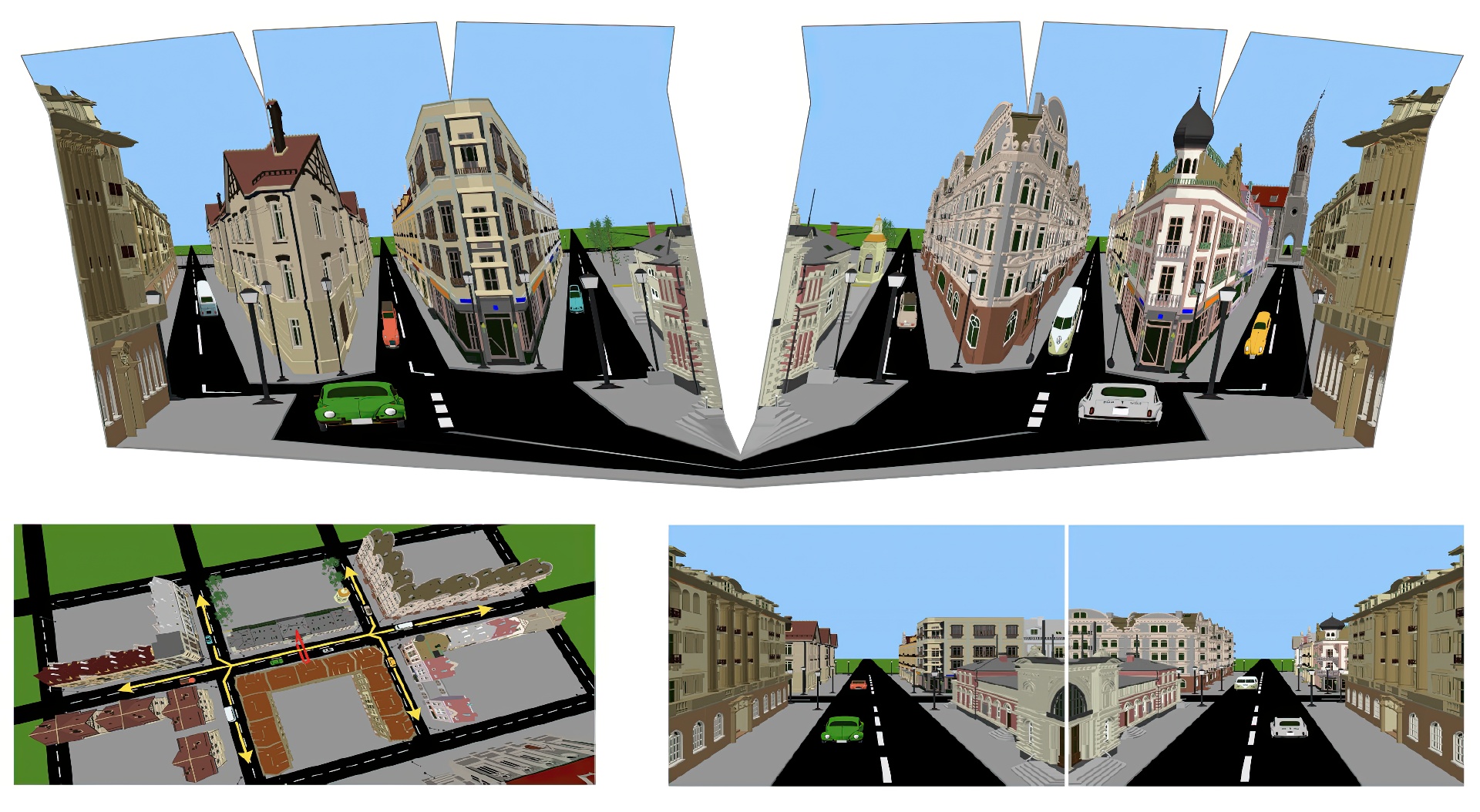“The graph camera”
Conference:
Type(s):
Title:
- The graph camera
Session/Category Title: 3D is fun
Presenter(s)/Author(s):
Moderator(s):
Abstract:
A conventional pinhole camera captures only a small fraction of a 3-D scene due to occlusions. We introduce the graph camera, a non-pinhole with rays that circumvent occluders to create a single layer image that shows simultaneously several regions of interest in a 3-D scene. The graph camera image exhibits good continuity and little redundancy. The graph camera model is literally a graph of tens of planar pinhole cameras. A fast projection operation allows rendering in feed-forward fashion, at interactive rates, which provides support for dynamic scenes. The graph camera is an infrastructure level tool with many applications. We explore the graph camera benefits in the contexts of virtual 3-D scene exploration and summarization, and in the context of real-world 3-D scene visualization. The graph camera allows integrating multiple video feeds seamlessly, which enables monitoring complex real-world spaces with a single image.
References:
1. Agrawala, M., Zorin, D., and Munzner, T. 2000. Artistic Multiprojection Rendering. EG Workshop on Rendering Techniques 2000, 125–136. Google ScholarDigital Library
2. Agarwala, A. et al., 2006. Photographing long scenes with multi-viewpoint panoram. SIGGRAPH 2006, 853–861. Google ScholarDigital Library
3. Chen, E. QuickTime VR. SIGGRAPH ’95, 29–38. Google ScholarDigital Library
4. Diepstraten, J., Weiskopf, D., and Ertl, T., 2002. Transparency in interactive technical illustrations. Computer Graphics Forum, 21(3):317–325.Google ScholarCross Ref
5. Diepstraten, J., Weiskopf, D., and Ertl, T., 2003. Interactive cutaway rendering. EUROGRAPHICS 2003, 523–532.Google Scholar
6. Elmqvist, N., 2005. BalloonProbe: Reducing Occlusion in 3D using Interactive Space Distortion. ACM Symposium on Virtual Reality Software and Technology 2005, 134–137. Google ScholarDigital Library
7. Furnas, G. W, 1986. Generalized fisheye views. ACM CHI’86 Conference on Human Factors in Computer Syst., 16–23. Google ScholarDigital Library
8. Gortler, S. J., Grzeszczuk, R., Szeliski, R., and Cohen, M. F. 1996. The lumigraph. SIGGRAPH ’96, 43–54. Google ScholarDigital Library
9. Klein, A. W., Sloan, P. J., Finkelstein, A., and Cohen, M. F. 2002. Stylized video cubes. Siggraph/Eurographics Symposium on Computer Animation SCA ’02, 15–22. Google ScholarDigital Library
10. Kuthirummal S. and Nayar S. Multiview Radial Catadioptric Imaging for Scene Capture. SIGGRAPH ’06. Google ScholarDigital Library
11. Lamping, J., and Rao, R., 1996. The Hyperbolic Browser: A focus + context technique for visualizing large hierarchies. Journal of Visual Languages and Computing, 7(1):33–35.Google ScholarCross Ref
12. Levoy, M. and Hanrahan, P. 1996. Light field rendering. SIGGRAPH ’96, 31–42. Google ScholarDigital Library
13. Mei, C., Popescu, V., and Sacks, E. 2005. The Occlusion Camera. Eurographics 2005, 335–342.Google Scholar
14. Nomura, Y., L. Zhang, and S. Nayar 2007. Scene collages and flexible camera arrays. EG Symp. on Rendering, 2007. Google ScholarCross Ref
15. Ponce, J. 2009. What is a camera. IEEE Conference on Computer Vision and Pattern Recognition, 2009.Google ScholarCross Ref
16. Popescu, V., Aliaga, D. 2006. The depth discontinuity occlusion camera. ACM Symp. on Interactive 3-D Graphics, 139–143. Google ScholarDigital Library
17. Rademacher, P. and Bishop, G. 1998. Multiple-center-of-projection images. SIGGRAPH ’98, 199–206. Google ScholarDigital Library
18. Roman, A., Garg, G., and Levoy, M. 2004. Interactive Design of Multi-Perspective Images for Visualizing Urban Landscapes. Visualization ’04, 537–544. Google ScholarDigital Library
19. Roman, A., Lensch, H. P. A. 2006. Automatic Multiperspective Images. Eurogr. Symposium on Rendering, 537–544. Google ScholarCross Ref
20. Rosen, P., and Popescu, V. 2008. The epipolar occlusion camera. ACM Symp. on Interactive 3-D Graphics, 2008, 115–122. Google ScholarDigital Library
21. Seitz, S. M. and Kim, J. 2003. Multiperspective Imaging. IEEE Comput. Graph. Appl. 23, 6 (Nov. 2003), 16–19. Google ScholarDigital Library
22. Shade, J., Gortler, S., He, L., and Szeliski, R. 1998. Layered depth images. SIGGRAPH ’98, 231–242. Google ScholarDigital Library
23. Szeliski, R., and Shum, H.-Y. 1997. Full view panoramic image mosaics and texture-mapped models. SIGG ’97, 251–258. Google ScholarDigital Library
24. Wong N., Carpendale, M. S. T., and Greenberg, S., 2003. EdgeLens: An interactive method for managing edge congestion in graphs. IEEE Symp. on Info. Vis. 2003, 51–58. Google ScholarDigital Library
25. Wood, D. N., Finkelstein, A., Hughes, J. F., Thayer, C. E., and Salesin, D. H. 1997. Multiperspective panoramas for cel animation. SIGGRAPH ’97, 243–250. Google ScholarDigital Library
26. Yu, J., and McMillan, L. 2004. General Linear Cameras European Conf. on Computer Vision 2004, Vol. 2, 14–27.Google Scholar
27. Yu, J., and McMillan, L. 2004. A Framework for Multiperspective Rendering. Eurographics Symposium on Rendering 2004, 61–68. Google ScholarCross Ref
28. Yu, J., and McMillan, L. 2005. Analyzing Reflections via Multiperspective Imaging. Computer Vision and Pattern Recognition (CVPR), 2005, 117–124. Google ScholarDigital Library





